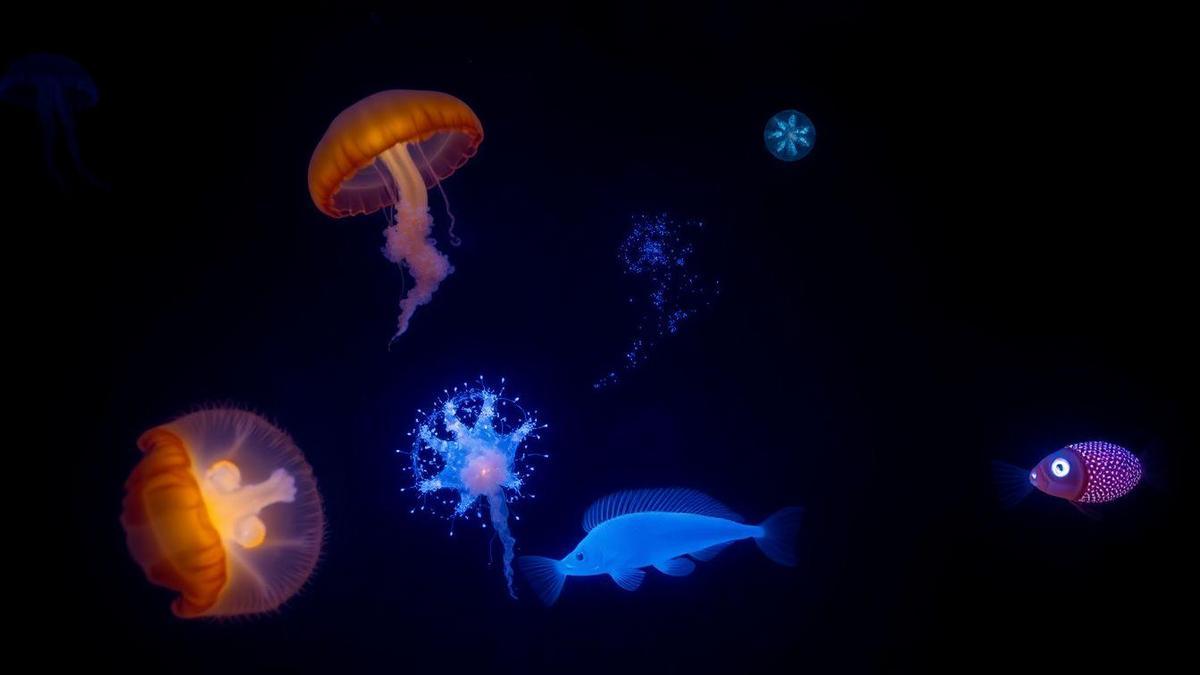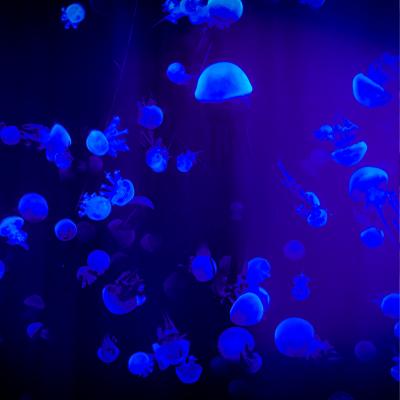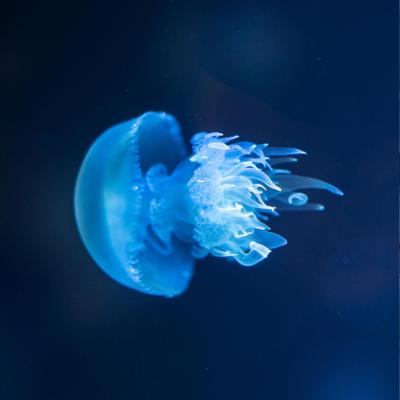Anúncios
Marine bioluminescence is a phenomenon that fascinates scientists and the curious alike due to its beauty and complexity. Marine organisms such as dinoflagellates, fish, and jellyfish emit their own light through chemical reactions. These reactions play essential roles in the survival and interaction of these beings in the ocean environment.
In addition to its functionality, bioluminescence also inspires technological and scientific applications. Its study allows us to explore marine biodiversity and understand surprising evolutionary adaptations. This natural light is, therefore, both a biological resource and a bridge to innovation.
Anúncios

The Chemistry Behind Marine Light
The basis of bioluminescence lies in a reaction between luciferin and luciferase. When luciferin is oxidized, it releases energy in the form of light. This transformation occurs in the presence of oxygen and, in some cases, additional cofactors.
Each organism has its own variation of these molecules, adapted to its environment. This results in different intensities, durations, and colors of light. In the ocean, blue-green light predominates, as it penetrates water more effectively.
Bioluminescence can occur in specialized tissues called photophores. These organs have structures that control the emission and direction of light. Some fish, for example, have natural “lampshades” under their eyes.
Studying these chemical processes helps researchers develop fluorescent genetic markers. The same light that guides a fish can now illuminate human cells in medical studies. Nature once again provides elegant solutions to modern challenges.
Ecological Functions of Bioluminescence
Bioluminescence has functions that go beyond simple visual display. In many organisms, it is essential for survival, reproduction, and hunting. These functions make this phenomenon a tool of ecological adaptation.
Many fish and crustaceans use light to confuse predators. They emit sudden flashes or release luminous clouds when threatened. This tactic creates effective distractions during escape.
Others use it as bait to attract prey in dark environments. The anglerfish, for example, glows in front of its mouth, luring in unsuspecting curious creatures. This luminous trap is an efficient strategy in the deep sea.
In reproduction, luminous patterns function as signals to attract partners. Each species has its own “light code,” recognized by mates. This ensures successful encounters even in abyssal darkness.
Diversity of Bioluminescent Organisms

Marine bioluminescence appears in a wide variety of life forms. From microscopic bacteria to fish and jellyfish, all can emit light. This evolutionary trait emerged independently in different groups.
Dinoflagellates are some of the best known and cause the glow in nighttime waves. When disturbed, they release light in response to water movement. These events are especially visible on tropical beaches.
Some jellyfish use bioluminescence for both defense and attraction. Their gelatinous bodies flash rhythmically in bluish tones. These pulses can disorient predators or attract the attention of prey.
In deep-sea fish, light is a necessity. Living where sunlight does not reach, they depend on it to see and be seen. Each species adapts its light emission to its specific ecological needs.
How Does Marine Bioluminescence Work and Which Organisms Produce Their Own Light?
Marine bioluminescence is a fascinating natural phenomenon that occurs when living organisms produce and emit light. This ability is found in various marine species, including certain types of fish, jellyfish, and microorganisms such as dinoflagellates and bacteria. The light produced by these organisms results from biochemical reactions involving a molecule called luciferin and an enzyme known as luciferase. When luciferin is oxidized by luciferase in the presence of oxygen, it produces light, often in the blue-green spectrum, which is particularly effective for underwater visibility.
The mechanisms behind bioluminescence can vary significantly among different organisms. Some species use this light for communication, attracting mates, or deterring predators, while others use it to attract prey. The efficiency of bioluminescence in the deep sea is especially remarkable, as light can travel long distances in water, allowing organisms to interact across vast spaces. Light production is often regulated by the organism’s circadian rhythms, environmental factors, and the presence of certain chemicals, making it a complex and adaptive trait.
Beyond its biological importance, marine bioluminescence captures the imagination of scientists and the general public. The mesmerizing glow of bioluminescent organisms can create stunning visual displays in the ocean, such as the glowing waves caused by bioluminescent plankton. This phenomenon has led to extensive research on the ecological roles of bioluminescence and its potential applications in biotechnology, medicine, and environmental monitoring. Understanding how these organisms produce light enriches our knowledge of marine ecosystems and opens new avenues for innovation in various fields.
Advantages of Marine Bioluminescence and the Organisms That Produce Their Own Light
The advantages of marine bioluminescence are diverse, significantly impacting the survival and behavior of marine organisms. One of the main benefits is the ability to evade predators. Many species have evolved bioluminescent capabilities that allow them to create light flashes or even produce a cloud of luminous material when threatened. This behavior can confuse predators, providing the prey with a critical opportunity to escape. The strategic use of light in this context highlights the evolutionary advantages conferred by bioluminescence in predator-prey interactions.
Another significant advantage of bioluminescence is its role in communication among marine species. Many organisms use light signals to attract mates, establish territory, or warn of potential dangers. For example, certain oceanic firefly species use specific light patterns to signal their readiness to mate, while some fish employ bioluminescent displays to assert dominance. This form of communication is particularly important in the dark depths of the ocean, where visibility is limited and visual signals become essential for social interactions.
Additionally, bioluminescence plays a crucial role in the hunting strategies of some marine predators. Organisms like the lanternfish have developed unique adaptations that allow them to use bioluminescent lures to attract unsuspecting prey. By emitting light from specialized organs, these predators can lure in fish and other organisms, making hunting more efficient. This not only improves their feeding success but also contributes to the overall balance of marine ecosystems.
Finally, bioluminescence has attracted attention for its potential applications in various scientific fields. Researchers are exploring the use of bioluminescent proteins in medical imaging, environmental monitoring, and even in the development of sustainable lighting solutions. The unique properties of bioluminescent organisms provide valuable insights into cellular processes and may lead to innovative technologies that benefit society. The advantages of marine bioluminescence go beyond the ocean, highlighting its importance in both ecological and technological contexts.
How Marine Bioluminescence Occurs and the Organisms That Produce Their Own Light

Marine bioluminescence occurs through a series of intricate biochemical processes that allow organisms to produce light. The main components involved in this process are luciferin, the light-emitting molecule, and luciferase, the enzyme that catalyzes the reaction. When luciferin is oxidized by luciferase in the presence of oxygen, it produces light as a byproduct. This reaction can occur in various tissues of the organism, depending on the species and its specific adaptations. The color and intensity of the emitted light can vary based on the type of luciferin involved and environmental conditions.
In many bioluminescent organisms, light production is tightly regulated by the organism’s internal biological clock. This circadian rhythm influences when and how much light is produced, allowing organisms to synchronize their bioluminescent displays with their behavioral patterns. For example, some species may emit light only at specific times of day or in response to particular stimuli, such as the presence of predators or mates. This regulation ensures that bioluminescence serves its purpose, whether for communication, defense, or hunting.
The occurrence of bioluminescence is not limited to a single group of organisms; it has evolved independently in several taxa over millions of years. This phenomenon can be found in a diverse range of marine life, including bacteria, dinoflagellates, jellyfish, and deep-sea fish. Each group has developed distinct biochemical pathways and adaptations that allow them to harness bioluminescence for survival. The evolutionary pressures that shaped these adaptations highlight the importance of bioluminescence in marine ecosystems and the competitive advantages it provides.
In addition, environmental factors play a significant role in the occurrence of bioluminescence. Certain conditions, such as nutrient availability and water temperature, can influence the abundance and activity of bioluminescent organisms. In some cases, bioluminescent phytoplankton blooms may occur in response to changes in water chemistry or temperature, creating dazzling displays in coastal waters. Understanding the interaction between bioluminescence and environmental factors is crucial for grasping the dynamics of marine ecosystems and the potential impacts of climate change on these unique organisms.
Did You Enjoy Learning About Marine Bioluminescence and Organisms Producing Their Own Light?
Marine bioluminescence is a captivating phenomenon that demonstrates the incredible adaptations of various organisms in the ocean.
Light production involves complex biochemical processes, primarily driven by luciferin and luciferase.
Bioluminescence serves multiple purposes, including predator evasion, communication, and hunting strategies.
The unique properties of bioluminescent organisms have inspired scientific research and technological innovations.
Environmental factors play a significant role in the occurrence and patterns of bioluminescence in marine ecosystems.
Understanding marine bioluminescence increases our appreciation for the diversity and complexity of ocean life.
In conclusion, the study of marine bioluminescence and the organisms that produce their own light offers a glimpse
into the wonders of the natural world. From dazzling visual displays in the ocean to potential applications in science and technology, there is much to explore and learn about this captivating phenomenon. As we continue to uncover the mysteries of bioluminescence, we deepen our understanding of marine ecosystems and the intricate relationships that exist within them.
Frequently Asked Questions
What is marine bioluminescence and which organisms produce their own light?
Marine bioluminescence is the ability of some organisms to emit light. Many types of fish, jellyfish, and even some kinds of plankton do this!
How do organisms manage to produce light?
They use a chemical reaction. Typically, a protein called luciferin binds with oxygen, and an enzyme called luciferase makes everything glow!
Where can we find bioluminescent organisms?
You can mostly find them in the ocean. Places like deep zones and sandbanks are their favorite homes.
What do organisms use bioluminescence for?
They use light to defend themselves, find food, or communicate. It’s like they have their own little lamps!
Is marine bioluminescence the same as in insects like fireflies?
Not exactly. Both are bioluminescent, but insects and marine organisms have different processes. It’s fascinating to see how diverse nature is!
